《中欧全面投资协定》投资者-东道国争端解决机制构想——以ISDS改革为视角
- 格式:doc
- 大小:79.00 KB
- 文档页数:30
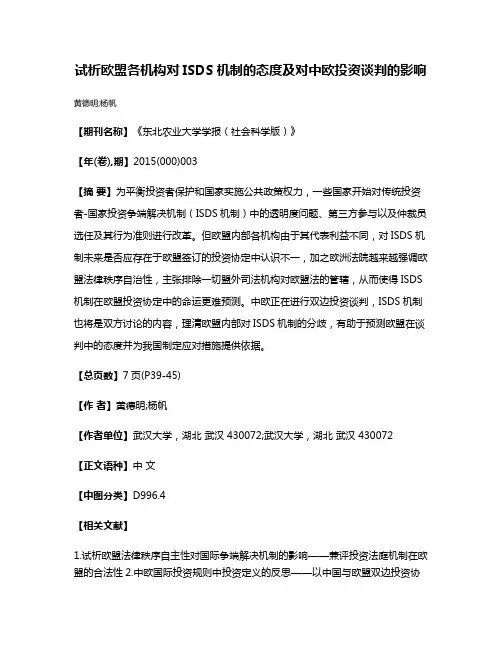
试析欧盟各机构对ISDS机制的态度及对中欧投资谈判的影响黄德明;杨帆
【期刊名称】《东北农业大学学报(社会科学版)》
【年(卷),期】2015(000)003
【摘要】为平衡投资者保护和国家实施公共政策权力,一些国家开始对传统投资者-国家投资争端解决机制(ISDS机制)中的透明度问题、第三方参与以及仲裁员选任及其行为准则进行改革。
但欧盟内部各机构由于其代表利益不同,对ISDS机制未来是否应存在于欧盟签订的投资协定中认识不一,加之欧洲法院越来越强调欧盟法律秩序自治性,主张排除一切盟外司法机构对欧盟法的管辖,从而使得ISDS 机制在欧盟投资协定中的命运更难预测。
中欧正在进行双边投资谈判,ISDS机制也将是双方讨论的内容,理清欧盟内部对ISDS机制的分歧,有助于预测欧盟在谈判中的态度并为我国制定应对措施提供依据。
【总页数】7页(P39-45)
【作者】黄德明;杨帆
【作者单位】武汉大学,湖北武汉 430072;武汉大学,湖北武汉 430072
【正文语种】中文
【中图分类】D996.4
【相关文献】
1.试析欧盟法律秩序自主性对国际争端解决机制的影响——兼评投资法庭机制在欧盟的合法性
2.中欧国际投资规则中投资定义的反思——以中国与欧盟双边投资协
定谈判为视角3.论中国与欧盟BIT谈判中的ISDS机制4.试析欧盟法律秩序自主性对国际争端解决机制的影响——兼评投资法庭机制在欧盟的合法性5.全球治理体制变革中欧盟ISDS机制革新评析
因版权原因,仅展示原文概要,查看原文内容请购买。
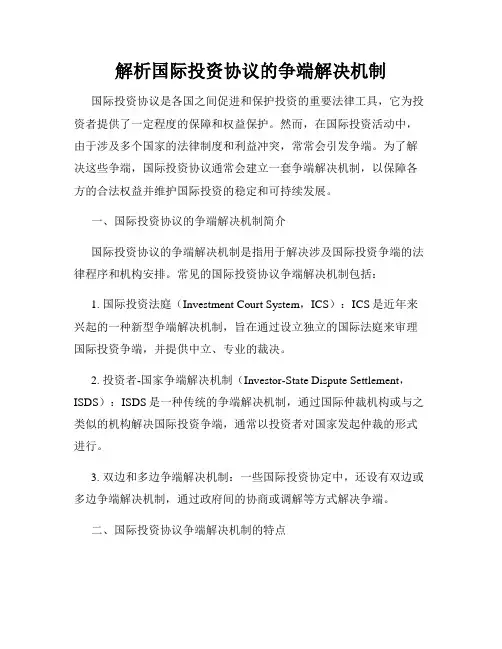
解析国际投资协议的争端解决机制国际投资协议是各国之间促进和保护投资的重要法律工具,它为投资者提供了一定程度的保障和权益保护。
然而,在国际投资活动中,由于涉及多个国家的法律制度和利益冲突,常常会引发争端。
为了解决这些争端,国际投资协议通常会建立一套争端解决机制,以保障各方的合法权益并维护国际投资的稳定和可持续发展。
一、国际投资协议的争端解决机制简介国际投资协议的争端解决机制是指用于解决涉及国际投资争端的法律程序和机构安排。
常见的国际投资协议争端解决机制包括:1. 国际投资法庭(Investment Court System,ICS):ICS是近年来兴起的一种新型争端解决机制,旨在通过设立独立的国际法庭来审理国际投资争端,并提供中立、专业的裁决。
2. 投资者-国家争端解决机制(Investor-State Dispute Settlement,ISDS):ISDS是一种传统的争端解决机制,通过国际仲裁机构或与之类似的机构解决国际投资争端,通常以投资者对国家发起仲裁的形式进行。
3. 双边和多边争端解决机制:一些国际投资协定中,还设有双边或多边争端解决机制,通过政府间的协商或调解等方式解决争端。
二、国际投资协议争端解决机制的特点1. 法律约束力:国际投资协议争端解决机制是基于法律的,各方必须依据协议的规定进行争端解决,受到国际法和国际投资法的约束。
2. 中立公正:争端解决机制应当确保中立、公正的原则,保证争端案件的审理过程公正无私,不偏袒任何一方。
3. 专业性:争端解决机制需要具备专业的仲裁人员和法官,他们必须具备相关领域的专业知识和经验,以便正确、准确地理解和解决争端。
三、国际投资协议争端解决机制的优势与挑战1. 优势国际投资协议争端解决机制的建立和运行,有助于吸引更多的投资者投资到相关国家,为投资者提供了对外投资的法律保障和争端解决途径。
同时,争端解决机制的中立性和专业性,可以提高争端解决的效率和公正性,为各方提供一个公平竞争的环境。
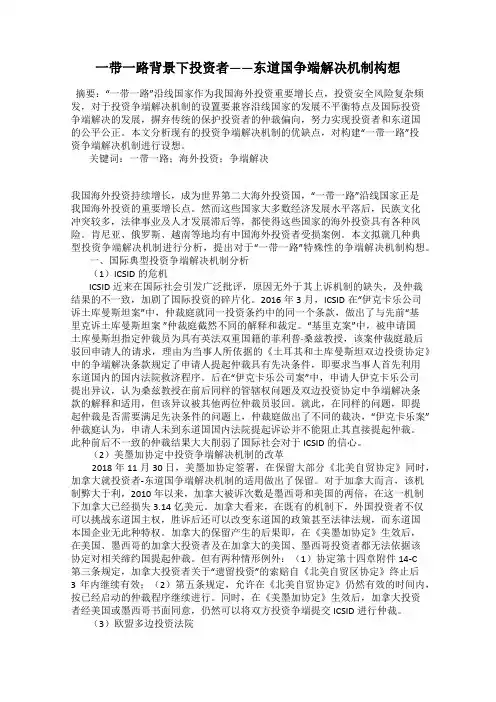
一带一路背景下投资者——东道国争端解决机制构想摘要:“一带一路”沿线国家作为我国海外投资重要增长点,投资安全风险复杂频发,对于投资争端解决机制的设置要兼容沿线国家的发展不平衡特点及国际投资争端解决的发展,摒弃传统的保护投资者的仲裁偏向,努力实现投资者和东道国的公平公正。
本文分析现有的投资争端解决机制的优缺点,对构建“一带一路”投资争端解决机制进行设想。
关键词:一带一路;海外投资;争端解决我国海外投资持续增长,成为世界第二大海外投资国,“一带一路”沿线国家正是我国海外投资的重要增长点。
然而这些国家大多数经济发展水平落后,民族文化冲突较多,法律事业及人才发展滞后等,都使得这些国家的海外投资具有各种风险。
肯尼亚、俄罗斯、越南等地均有中国海外投资者受损案例。
本文拟就几种典型投资争端解决机制进行分析,提出对于“一带一路”特殊性的争端解决机制构想。
一、国际典型投资争端解决机制分析(1)ICSID的危机ICSID近来在国际社会引发广泛批评,原因无外于其上诉机制的缺失,及仲裁结果的不一致,加剧了国际投资的碎片化。
2016年3月,ICSID在“伊克卡乐公司诉土库曼斯坦案”中,仲裁庭就同一投资条约中的同一个条款,做出了与先前“基里克诉土库曼斯坦案”仲裁庭截然不同的解释和裁定。
“基里克案”中,被申请国土库曼斯坦指定仲裁员为具有英法双重国籍的菲利普·桑兹教授,该案仲裁庭最后驳回申请人的请求,理由为当事人所依据的《土耳其和土库曼斯坦双边投资协定》中的争端解决条款规定了申请人提起仲裁具有先决条件,即要求当事人首先利用东道国内的国内法院救济程序。
后在“伊克卡乐公司案”中,申请人伊克卡乐公司提出异议,认为桑兹教授在前后同样的管辖权问题及双边投资协定中争端解决条款的解释和适用,但该异议被其他两位仲裁员驳回。
就此,在同样的问题,即提起仲裁是否需要满足先决条件的问题上,仲裁庭做出了不同的裁决,“伊克卡乐案”仲裁庭认为,申请人未到东道国国内法院提起诉讼并不能阻止其直接提起仲裁。
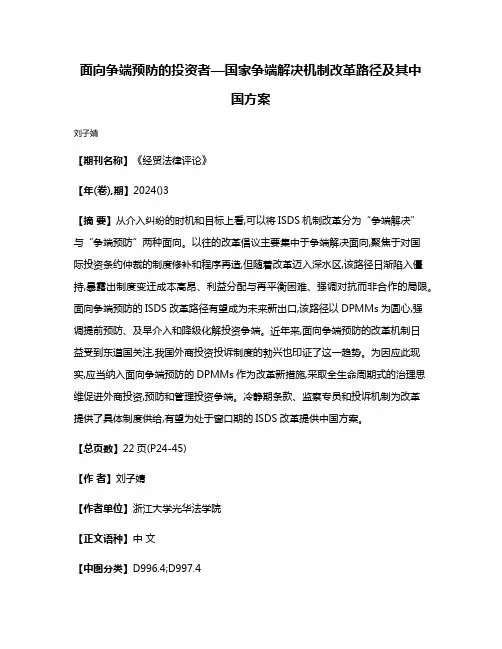
面向争端预防的投资者—国家争端解决机制改革路径及其中
国方案
刘子婧
【期刊名称】《经贸法律评论》
【年(卷),期】2024()3
【摘要】从介入纠纷的时机和目标上看,可以将ISDS机制改革分为“争端解决”
与“争端预防”两种面向。
以往的改革倡议主要集中于争端解决面向,聚焦于对国
际投资条约仲裁的制度修补和程序再造,但随着改革迈入深水区,该路径日渐陷入僵持,暴露出制度变迁成本高昂、利益分配与再平衡困难、强调对抗而非合作的局限。
面向争端预防的ISDS改革路径有望成为未来新出口,该路径以DPMMs为圆心,强
调提前预防、及早介入和降级化解投资争端。
近年来,面向争端预防的改革机制日
益受到东道国关注,我国外商投资投诉制度的勃兴也印证了这一趋势。
为因应此现实,应当纳入面向争端预防的DPMMs作为改革新措施,采取全生命周期式的治理思维促进外商投资,预防和管理投资争端。
冷静期条款、监察专员和投诉机制为改革
提供了具体制度供给,有望为处于窗口期的ISDS改革提供中国方案。
【总页数】22页(P24-45)
【作者】刘子婧
【作者单位】浙江大学光华法学院
【正文语种】中文
【中图分类】D996.4;D997.4
【相关文献】
1.发展中国家推动WTO争端解决机制前进“世贸组织争端解决机制:发展中国家经验共享”国际研讨会举行
2.投资者-国家争端解决机制的改革与中国对策
3.投资者--国家争端解决机制的多边改革:不同方案的对话
4.投资者-国家争端解决机制改革与中国应对
5.鼓励中小企业适用投资者-国家争端解决机制的改革与中国因应
因版权原因,仅展示原文概要,查看原文内容请购买。
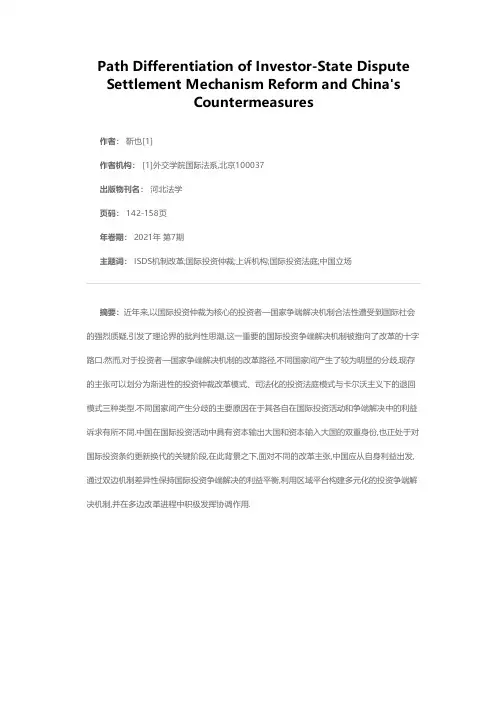
Path Differentiation of Investor-State Dispute Settlement Mechanism Reform and China's
Countermeasures
作者: 靳也[1]
作者机构: [1]外交学院国际法系,北京100037
出版物刊名: 河北法学
页码: 142-158页
年卷期: 2021年 第7期
主题词: ISDS机制改革;国际投资仲裁;上诉机构;国际投资法庭;中国立场
摘要:近年来,以国际投资仲裁为核心的投资者—国家争端解决机制合法性遭受到国际社会的强烈质疑,引发了理论界的批判性思潮,这一重要的国际投资争端解决机制被推向了改革的十字路口.然而,对于投资者—国家争端解决机制的改革路径,不同国家间产生了较为明显的分歧,现存的主张可以划分为渐进性的投资仲裁改革模式、司法化的投资法庭模式与卡尔沃主义下的退回模式三种类型.不同国家间产生分歧的主要原因在于其各自在国际投资活动和争端解决中的利益诉求有所不同.中国在国际投资活动中具有资本输出大国和资本输入大国的双重身份,也正处于对国际投资条约更新换代的关键阶段,在此背景之下,面对不同的改革主张,中国应从自身利益出发,通过双边机制差异性保持国际投资争端解决的利益平衡,利用区域平台构建多元化的投资争端解决机制,并在多边改革进程中积极发挥协调作用.。
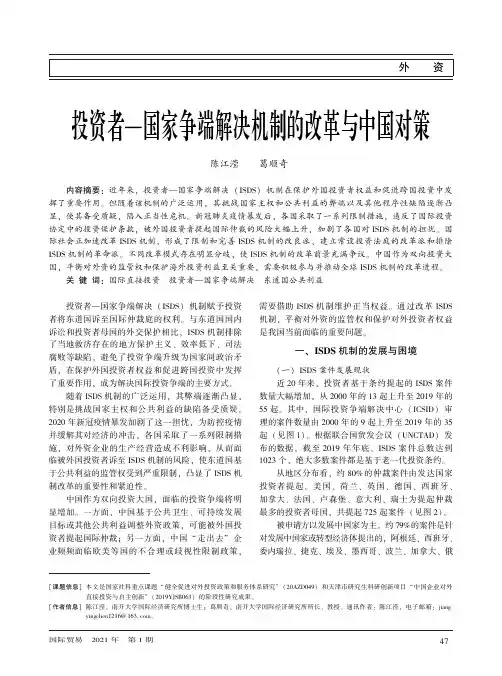

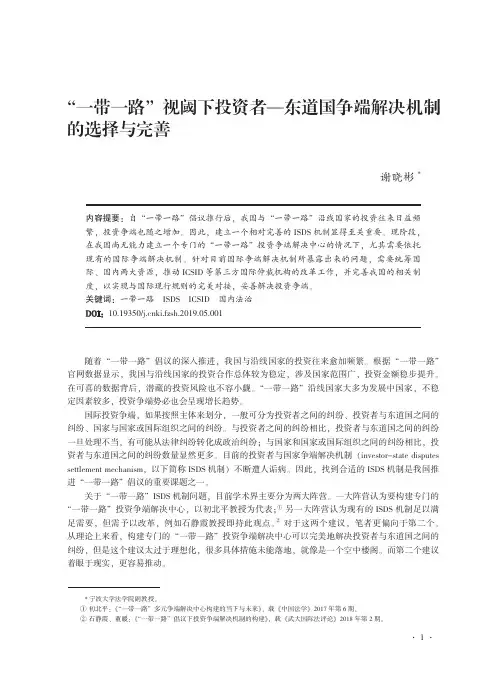
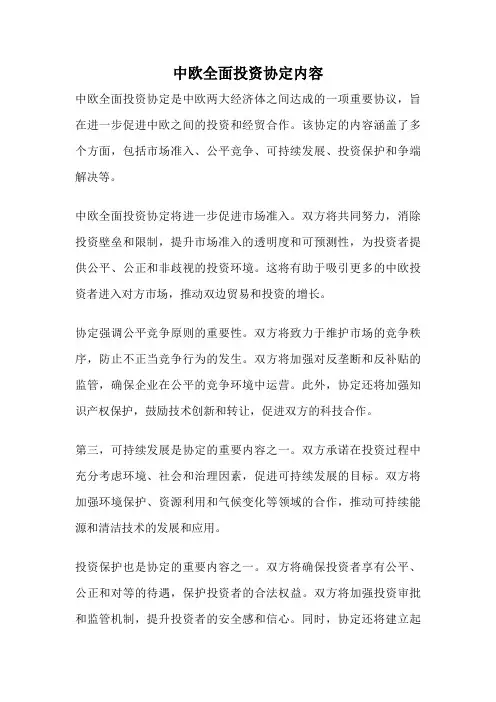
中欧全面投资协定内容中欧全面投资协定是中欧两大经济体之间达成的一项重要协议,旨在进一步促进中欧之间的投资和经贸合作。
该协定的内容涵盖了多个方面,包括市场准入、公平竞争、可持续发展、投资保护和争端解决等。
中欧全面投资协定将进一步促进市场准入。
双方将共同努力,消除投资壁垒和限制,提升市场准入的透明度和可预测性,为投资者提供公平、公正和非歧视的投资环境。
这将有助于吸引更多的中欧投资者进入对方市场,推动双边贸易和投资的增长。
协定强调公平竞争原则的重要性。
双方将致力于维护市场的竞争秩序,防止不正当竞争行为的发生。
双方将加强对反垄断和反补贴的监管,确保企业在公平的竞争环境中运营。
此外,协定还将加强知识产权保护,鼓励技术创新和转让,促进双方的科技合作。
第三,可持续发展是协定的重要内容之一。
双方承诺在投资过程中充分考虑环境、社会和治理因素,促进可持续发展的目标。
双方将加强环境保护、资源利用和气候变化等领域的合作,推动可持续能源和清洁技术的发展和应用。
投资保护也是协定的重要内容之一。
双方将确保投资者享有公平、公正和对等的待遇,保护投资者的合法权益。
双方将加强投资审批和监管机制,提升投资者的安全感和信心。
同时,协定还将建立起争端解决机制,为投资者提供有效的争端解决渠道。
中欧全面投资协定的签署将为中欧两大经济体之间的投资和经贸合作带来新的机遇。
协定的实施将促进双方贸易和投资的自由化和便利化,为企业创造更加稳定和可预测的投资环境。
这将有助于进一步加强中欧之间的经济联系,推动双方的共同发展。
中欧全面投资协定的签署将为中欧两大经济体之间的投资和经贸合作带来新的机遇。
协定的内容涵盖了市场准入、公平竞争、可持续发展、投资保护和争端解决等多个方面,旨在进一步促进中欧之间的投资和经贸合作。
协定的实施将为企业创造更加稳定和可预测的投资环境,推动双方的共同发展。
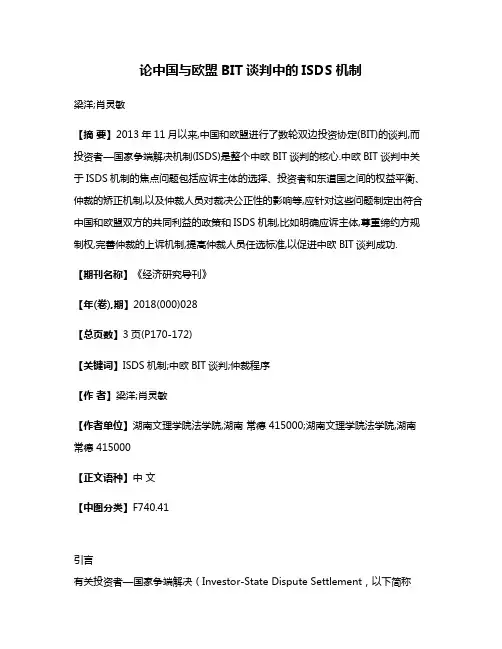
论中国与欧盟BIT谈判中的ISDS机制梁洋;肖灵敏【摘要】2013年11月以来,中国和欧盟进行了数轮双边投资协定(BIT)的谈判,而投资者—国家争端解决机制(ISDS)是整个中欧BIT谈判的核心.中欧BIT谈判中关于ISDS机制的焦点问题包括应诉主体的选择、投资者和东道国之间的权益平衡、仲裁的矫正机制,以及仲裁人员对裁决公正性的影响等,应针对这些问题制定出符合中国和欧盟双方的共同利益的政策和ISDS机制,比如明确应诉主体,尊重缔约方规制权,完善仲裁的上诉机制,提高仲裁人员任选标准,以促进中欧BIT谈判成功.【期刊名称】《经济研究导刊》【年(卷),期】2018(000)028【总页数】3页(P170-172)【关键词】ISDS机制;中欧BIT谈判;仲裁程序【作者】梁洋;肖灵敏【作者单位】湖南文理学院法学院,湖南常德 415000;湖南文理学院法学院,湖南常德 415000【正文语种】中文【中图分类】F740.41引言有关投资者—国家争端解决(Investor-State Dispute Settlement,以下简称ISDS)机制的设计是现今国际投资领域中最为突出的议题之一,也是中欧BIT谈判的重中之重,为了促进中国和欧盟两个位于世界前列的经济体的进一步合作和共同的繁荣,双方的双边投资协定(Bilateral Investment Treaty,以下简称BIT)势必要达成。
随着中国海外直接投资的增长,2016年中国海外直接投资量已经居于世界第二,再加上中国改革开放的不断扩大和“一带一路”的顺利进行,以后中国与欧盟及其成员国之间的投资争议也将会越来越多,为了在中国与欧盟BIT谈判中对投资者—国家争端提供有效的解决方案,我们有必要对ISDS机制进行更深入全面的研究。
一、ISDS机制概述1.ISDS机制的含义。
ISDS解决的争端只能是发生在东道国政府和外国投资者之间的争端,这是参与ISDS机制的主体的特殊性。
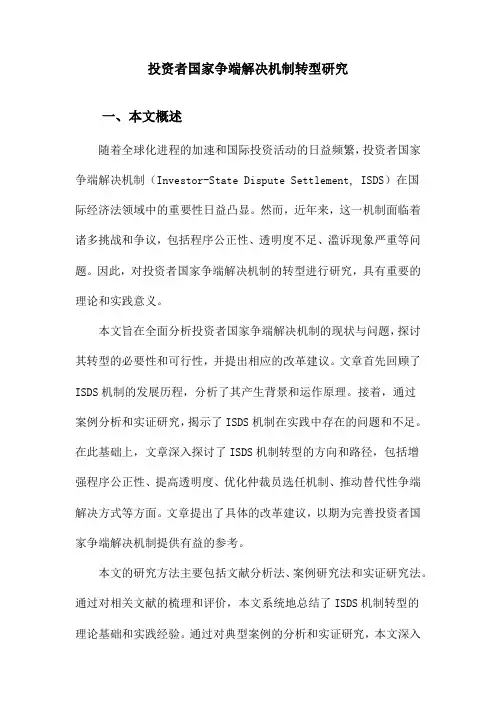
投资者国家争端解决机制转型研究一、本文概述随着全球化进程的加速和国际投资活动的日益频繁,投资者国家争端解决机制(Investor-State Dispute Settlement, ISDS)在国际经济法领域中的重要性日益凸显。
然而,近年来,这一机制面临着诸多挑战和争议,包括程序公正性、透明度不足、滥诉现象严重等问题。
因此,对投资者国家争端解决机制的转型进行研究,具有重要的理论和实践意义。
本文旨在全面分析投资者国家争端解决机制的现状与问题,探讨其转型的必要性和可行性,并提出相应的改革建议。
文章首先回顾了ISDS机制的发展历程,分析了其产生背景和运作原理。
接着,通过案例分析和实证研究,揭示了ISDS机制在实践中存在的问题和不足。
在此基础上,文章深入探讨了ISDS机制转型的方向和路径,包括增强程序公正性、提高透明度、优化仲裁员选任机制、推动替代性争端解决方式等方面。
文章提出了具体的改革建议,以期为完善投资者国家争端解决机制提供有益的参考。
本文的研究方法主要包括文献分析法、案例研究法和实证研究法。
通过对相关文献的梳理和评价,本文系统地总结了ISDS机制转型的理论基础和实践经验。
通过对典型案例的分析和实证研究,本文深入剖析了ISDS机制在实践中的运行状况和问题。
这些研究方法和数据来源保证了本文分析的全面性和深入性。
本文旨在全面研究投资者国家争端解决机制的转型问题,为相关领域的改革提供有益的参考和建议。
通过对ISDS机制的现状与问题、转型方向和路径以及改革建议的深入探讨,本文旨在为完善国际投资争端解决机制、促进国际投资活动的健康发展贡献智慧和力量。
二、ISDS机制的历史与现状分析投资者国家争端解决机制(ISDS)的历史可以追溯到上世纪中叶,当时随着国际投资的增加,投资者与东道国之间的争端也日益增多。
为了为投资者提供一个公正、透明的争端解决平台,ISDS机制应运而生。
它旨在通过仲裁方式解决投资者与东道国之间的争议,以保护投资者的权益并促进国际投资的流动。
投资者一国家争端解决机制的新发展作者:廖凡来源:《江西社会科学》 2017年第10期顺应国际投资格局及规则的演变,《跨大西洋伙伴关系协定》(TPP)的投资章节在投资者—国家争端解决机制(ISDS)的设计上呈现出一些新的特点,在若干细节上体现出对东道国主权权益的适当关切,包括启动投资仲裁的限制、仲裁员选任的要求、赔偿范围和费用承担的规定以及其他章节中的相关例外条款等。
尽管如此,ISDS机制向投资者倾斜的主基调并未改变,表现在上诉机制依然缺位、“岔路口”条款设置不够彻底、可供投资者选择的仲裁机构和规则更加多样化,以及ISDS仲裁裁决的执行同国家间争端解决机制相挂钩等。
在可以预见的将来,发达国家投资者利用国际仲裁挑战发展中国家的东道国规制权,仍将是ISDS机制运行中的“主旋律”。
[关键词]《跨大西洋伙伴关系协定》;投资者—国家争端解决机制;自由贸易协定;TPP;ISDS[中图分类号]D996.4[文献标识码]A[文章编号]1004-518X(2017)10-0200-09廖凡,中国社会科学院国际法研究所研究员,博士。
(北京100720)一、问题的提出投资者—国家争端解决机制(Investor-StateDisputeSettlement,ISDS)允许投资者(包括个人和企业)直接对东道国提起仲裁,在制度设计上将作为私主体的投资者与作为主权者的东道国置于平等地位,以凸显对投资者利益的保护。
作为一个单向机制,ISDS只能由投资者启动,亦即只能由投资者对东道国提起。
由此,ISDS构成对东道国主权权益的一大限制,也是双边投资条约(BilateralInvestmentTreaty,BIT)缔约方借以保护本国海外投资者利益的一大“利器”。
自其于20世纪60年代末崭露头角以来①,ISDS发展迅速,业已成为BIT的“标配”。
这应当符合BIT的传统定位:BIT起初主要是作为资本输出国的发达国家用以保护本国海外投资者的工具,直至20世纪末也主要是在发达国家与作为资本输入国的发展中国家之间签订,其基本宗旨和目的是促进和保护投资,故从形式到内容均以保护投资者利益为核心,而不甚考虑维护东道国的权益问题。
中国流通经济(2021年3月,第35卷第3期)China Business And Market (March 2021,Vol.35,No.3)收稿日期:2021-01-21基金项目:国家社会科学基金重大项目“中国海权发展模式及海洋法制完善研究”(17ZDA145);国家社会科学基金重大项目“构建人类命运共同体国际法治创新研究”(18ZDA153);国家社会科学基金重点项目“人类命运共同体国际法理论与实践研究”(18AFX025);国家社会科学基金“新时代海洋强国建设”重大研究专项“海洋命运共同体视野下的中国海洋权益维护研究”(19VHQ009)作者简介:荆鸣(1994—),女,辽宁省辽阳市人,大连海事大学法学院博士研究生,联合国粮农组织渔业与水产司实习研究人员,主要研究方向为国际经济法、竞争法、国际争端解决、海商法与海事法。
《中欧全面投资协定》的公平竞争规则:关切、安排与应对2020年12月30日,中欧领导人以视频方式共同宣布《中欧全面投资协定》(China-EU Compre⁃hensive Agreement on Investment ,CAI )谈判完成。
[1]中欧双方在经济体制、发展进程上存在巨大差异,在公平竞争规则上存在结构性分歧。
中方对谈判抱有极大诚意,国有企业的竞争中立要求在欧盟的强烈要求下纳入谈判,2020年7月第31轮谈判双方才就公平竞争规则取得一定的进展。
①[2]《中欧全面投资协定》的最终文本尚未公布。
本文借助国内外权威媒体传递的关键信息,厘清《中欧全面投资协定》谈判中双方有关公平竞争的关切,结合《中欧全面投资协定》可能包含的规则内容,观察这些内容对竞争中立要求的诠释;结合竞争中立要求在区域自贸协定中的扩张和变质,探究《中欧全面投资协定》谈判对为国有企业量身定制的特殊规制性安排的处理;结合欧盟外资安全审查制度的新发展,窥见其《关于外国补贴方面建立公平竞争环境的白皮书》(以下简称《补贴白皮书》)对《中欧全面投资协定》谈判的可能影响;梳理《中欧全面投资协定》可能对我国国有企业海外投资带来的潜在风险,并提出应对之策。
投资者作者:钱坤来源:《西部论丛》2019年第30期摘要:国际投资协定中的投资者—东道国争端解决(ISDS)机制成为当代投资协定中一个重要的组成部分,但其自身也存在着透明度差、自由裁量权过大、缺乏连贯性等制度性与技术性缺陷。
在此背景下,本文通过研究ISDS机制显现的问题以及分析中国在应对ISDS机制挑战中的态度以及措施。
认为中国应当在与各方的BIT谈判中坚持自己对ISDS机制的态度和基本立场,抓住谈判契机,谨慎筹谋努力促成谈判达成有利于中国的协定内容。
关键词:投资者—东道国争端解决机制;双边投资协定;BIT一、ISDS机制逐渐显现的一些问题第一,投资者要求财产权的稳定性和可预期性,而民族国家具有发展变化性,而且需要回应民众的诉求。
民族国家政府对于民众不断变化和提高的安全、健康、环保、福利的要求必须有所回应,这种回应通常体现为政策的变动,可能引发投资者-国家争端。
ISDS对于国家政策变动、体制变革的接受程度非常低。
例如,2010年,乌拉圭出于保护民众健康的目的,要求香烟外包装上显示损害健康的标志,而菲利普·莫里斯公司认为此举损害了自己的利益,运用瑞士-乌拉圭双边投资协定将乌拉圭政府告到ICSID。
该案初审仲裁至今仍未有结果。
以类似的理由,菲利普·莫里斯公司还将挪威和澳大利亚分别告上了欧洲自由贸易联盟法院和UNCITRAL特设法庭。
有意思的是,国际社会对于乌拉圭政府给予了许多道德支持和呼应。
可见,ISDS在很多情况下将民众的合理要求、政府的合理应对与外资利益保护对立起来,对主权国家政府制定法律、调整政策都可能产生极大限制。
[1]第二,ISDS在透明度、自由裁量权、连贯性、仲裁员资格等方面存在问题,使得它的合法性受到质疑。
在ISDS机制下,许多涉及巨大金额和重大利益的项目都是私下进行,外人很难获知仲裁的具体情况,使其透明度一直受到指责。
针對这种指责,UNCITRAL在2014年出台了新的透明度规则。
中欧双边投资条约中的投资者-国家争端解决机制——以欧盟投资法庭制度为视角邓婷婷【期刊名称】《政治与法律》【年(卷),期】2017(000)004【摘要】投资者-国家争端解决(ISDS)机制向来是国际投资协定谈判的关注重点之一,在中欧双边投资条约谈判中也不例外.为了回应近年来各界对ISDS机制的争议与批评,欧盟试图通过对传统ISDS机制进行改革而建立起投资法庭制度.与现有的ISDS机制相比较,投资法庭制度在具有强化国家规制权、加强裁判的合法性与公正性、确保裁判一致性与增强透明度等优点的同时,也面临关于投资法庭成员的相关规制有待细致化和科学化、上诉机制规则设计不合理、裁判的性质和执行问题存疑、与国内法院的关系有待澄清以及投资法庭制度规定碎片化等挑战.欧盟极可能在中欧双边投资条约谈判中提出建立投资法庭制度的建议,我国可以参与投资法庭制度的规则设定,且在仲裁范围、上诉机制的建立及透明度等问题上予以审慎考量,以期通过谈判累积参与国际投资治理的经验.【总页数】13页(P99-111)【作者】邓婷婷【作者单位】中南大学法学院,湖南长沙410012【正文语种】中文【中图分类】DF964【相关文献】1.印度投资条约之投资者与国家争端解决机制的最新发展与中国的应对 [J], 陶立峰2.论投资者与国家间投资争端仲裁中的法庭之友制度——基于ICSID体系下 [J], 史艳3.评析欧盟投资者诉国家争端解决机制的改革——以利益平衡为视角 [J], 李荻凡4.欧盟主导的投资法庭上诉机制及其对中欧投资争端解决机制的借鉴意义 [J], 汪梅清; 吴岚5.中国——东盟自由贸易区投资争端解决机制评析——以缔约方与投资者间争端解决为视角 [J], 陆以全因版权原因,仅展示原文概要,查看原文内容请购买。
摘要摘要随着国际投资的迅猛发展和国际投资协定数量激增,大量国际投资争端案件的审理使得传统的投资者—国家争端解决(ISDS)机制本身存在的问题开始凸显出来,ISDS机制的改革已经变成了国际投资领域的共识。
近年来,国内研究ISDS 机制改革的文献数量可观,但主要集中在ISDS机制存在的缺陷,尤其是与东道国公共利益平衡的关系上,最新研究则主要关注在ISDS机制的上诉机制构建的必要性、可行性与构建模式选择上。
作为ISDS机制改革新成果的跨太平洋伙伴关系协定(TPP)和跨大西洋贸易与投资伙伴协议((TTIP),由于其签署至今的时间跨度有限,所以鲜少有将其置于ISDS机制改革系统中进行横向对比的研究,本文将其纳入ISDS机制发展研究中,从ISDS机制产生背景与价值意义展开,介绍ISDS机制的争端主体以及其与其他争端解决机制的区别,明晰ISDS机制的内涵。
随后系统整理ISDS机制的在实践中的适用现状及其存在的问题,明确ISDS 机制改革的必然性及迫切性。
在此基础上,从TPP和TTIP两个目前影响力较大的协议中关于国际投资争端解决的不同思路,了解最新国际社会对于ISDS机制改革的不同路径选择。
最后通过对ISDS机制发展的全方位检视,结合我国对ISDS 机制改革的态度和国际投资中的涉华案例,对我国ISDS机制的改革提出建议。
鉴于我国目前对ISDS机制的改革更适合站在较为温和的改革立场,在ISDS机制改革过程中应重点考虑确定性与灵活性之间的平衡、兼顾公平与效率、新旧机制协兼容等方面因素,在理论层面加强ISDS机制的相关研究,在实践层面以双边投资协议(BIT)谈判为突破口,将改革从双边层面拓展至多边层面,最终形成更为公平合理的国际投资争端解决机制。
关键词:ISDS机制;TPP;TTIP;投资法庭ABSTRACTWith the rapid development of international investment and the surge in the number of international investment agreements,the trial of a large number of international investment dispute cases has begun to highlight the problems of the traditional invest-state dispute settlement(ISDS)mechanism,and the reform of the ISDS mechanism has become a consensus in the field of international investment.In recent years,the number of literatures on the reform of ISDS mechanism in China has been considerable,but mainly focused on the shortcomings of ISDS mechanism, especially in relation to the balance of public interest in the host country.The latest research focuses on the necessity of constructing the appeal mechanism of ISDS mechanism,Feasibility and construction mode selection.The Trans-Pacific Partnership Agreement(TPP)and the Transatlantic Trade and Investment Partnership Agreement (TTIP)as a new result of the reform of the ISDS mechanism,due to the limited time span since its signing,have rarely placed it in the ISDS mechanism reform system In the study of horizontal contrast.This paper incorporates it into the development of ISDS mechanism,and develops the background and value significance of the ISDS mechanism,introduces the dispute subject of the ISDS mechanism and its difference with other dispute resolution mechanisms,and clarifies the connotation of the ISDS mechanism.To clarify the application status of the ISDS mechanism in practice and its existing problems,and to clarify the inevitability and urgency of the reform of the ISDS mechanism.On this basis,from the current influential agreements between TPP and TTIP,the international investment dispute settlement different ideas to understand the different path choices of the latest international society for the reform of the ISDS mechanism.Finally,through the comprehensive review of the development of the ISDS mechanism,combined with China’s attitude towards the reform of the ISDS mechanism and the case involving China in international investment,the ISDS mechanism of China Reform proposes.In view of China’s current reform of the ISDS mechanism,it is more suitable to stand in a more moderate reform position.In the process of reforming the ISDS mechanism,we should focus on the balance between certainty and flexibility,taking into account factors such as fairness and efficiency, compatibility of new and old mechanisms,and strengthen the research on the ISDS mechanism at the theoretical level.Bilateral invest treaty(BIT)Negotiation is abreakthrough,and the reform will be expanded from the bilateral level to the multilateral level,eventually forming a more fair and reasonable international investment dispute settlement mechanism.Key words:ISDS mechanism;TPP;TTIP;Investment Court System目录引言 (1)第1章ISDS机制概述 (3)1.1ISDS机制产生背景及价值意义 (3)1.1.1产生背景 (3)1.1.2价值意义 (4)1.2ISDS机制的内涵 (5)1.2.1ISDS机制的概念界定 (5)1.2.2争端主体 (5)1.2.3与其他争端解决方式的比较 (6)第2章ISDS机制适用现状及其存在的问题 (8)2.1ISDS机制的适用现状 (8)2.1.1ISDS机制条约适用现状 (8)2.1.2ISDS机制案件实践现状 (8)2.2ISDS机制实践中的主要问题 (10)2.2.1仲裁程序缺乏透明度 (11)2.2.2损害东道国公共利益 (11)2.2.3仲裁裁决缺乏一致性 (12)第3章ISDS机制的改革路径 (14)3.1改良派:以《跨太平洋伙伴关系协定》(TPP)为例 (14)3.1.1防止投资者滥诉 (14)3.1.2提高仲裁程序透明度 (16)3.1.3一裁终局制度的沿革 (17)3.2变革派:以《跨大西洋贸易与投资伙伴协议》(TTIP)投资草案为例 (18)3.2.1仲裁员选任制度的革新 (18)3.2.2“U-Turn”条款替代用尽当地救济原则 (20)3.2.3创设投资法庭制度 (21)第4章ISDS机制发展对中国的启示 (23)4.1中国适用ISDS机制现状 (23)4.1.1对ISDS机制的态度 (23)4.1.2ISDS机制中的涉华案例 (24)4.2ISDS机制发展对中国的启示 (25)4.2.1中国ISDS机制改革路径选择 (25)4.2.2改革过程中重点考虑因素 (26)4.2.3具体举措建议 (27)结语 (29)致谢 (30)参考文献 (31)引言自2006年“国际投资仲裁正当性危机”这一问题被提出以来,与ISDS机制研究相关的议题开始引起学界的关注与讨论。
《中欧全面投资协定》投资者-东道国争端解决机制构想——以ISDS改革为视角An Outlook for the Possible ISDS Mechanism of China-EU Comprehensive Agreement on Investment — from the Perspective of ISDS ReformIn 2014, China and the European Union (“EU”) initiated their first round of negotiations on the investment agreement. After 35 rounds of “tug-of-war”, on 30th December 2020, China and the EU have finally concluded in principle the negotiations for the Comprehensive Agreementon Investment(“CAI”). The text of the CAI is partially released on 22nd January 2021.2014年,中国和欧盟启动了第一轮的投资协定谈判。
历经35轮拉锯,双方最终于2020年12月30日完成了《中欧全面投资协定》(EU-China Comprehensive Agreement on Investment,“CAI”)的谈判,并于2021年1月22日公布了CAI 部分文本。
[1]The CAI aims to replace and unify the bilateral investment treaties (BITs) entered by China and 26 out of the 27 member countries of the EU respectively so as to establish a unified multilateral institutional framework, which covers, inter alia, the market access commitments, information transparency, fair trading and competition, fair labor treatment, sustainabledevelopment and etc. It is worth noting that, in regard to the dispute resolution mechanism, the CAI has not directly set out a set of rules for the Investor-State Dispute Settlement (“ISDS”), but adopted the similar route as is in the Regional Comprehensive Economic Partnership (RCEP), which was signed by and among China, Japan, Korea, Australia, New Zealand and the 10 member countries of the Association of Southeast Asian Nations on 15th November 2020. That is, the signatory parties vowed to conclude the negotiations on ISDS mechanism within 2 years after the signing of the CAI. China and the EU had also specifically agreed that such ISDS mechanism would take into account of the ISDS reform currently carried out by the United Nations Commission for International Trade Law (“UNCITRAL”). In this regard, what kind of ISDS mechanism that will be finally adopted in the CAI is particularly worth the attention.《中欧全面投资协定》旨在取代中国和欧盟其中26个成员国之间现有的双边投资条约,建立一个统一的制度性框架,其中涉及市场准入、透明度、公平竞争、劳工待遇、可持续发展等等方面。
然而,值得注意的是,《中欧全面投资协定》中关于投资者-东道国争端解决(Investor-State Dispute Settlement,“ISDS”)机制方面没有具体规定,而是采取类似于中国与日本、韩国、澳大利亚、新西兰及东南亚国家联盟十国共十五方于2020年11月15日正式签署的《区域全面经济伙伴关系协定》(Regional Comprehensive Economic Partnership,“RCEP”)中的约定,即缔约方承诺在该协议签署后的2年内完成ISDS机制的谈判。
中欧双方在CAI中还特别承诺,该ISDS机制的设立将会考虑联合国国际贸易法委员会(UNCITRAL)组织下的ISDS改革(“ISDS改革”)方面获得的相关工作成果。
[2]如此一来,《中欧全面投资协定》最终将采取何种ISDS机制,就尤为值得关注与期待。
In light of the above, this article will first introduce the ISDS reform led by the UNCITRAL with particular attention paid on the reform submissions by China and the EU, which may shed a light on the possible positions to be adopted by China and the EU in the CAI with respect to ISDS mechanism. Based on the above analysis together with the consensus and progress achieved so far in the ISDS reform, this article will then look forward to the ISDS mechanism that may be eventually adopted in the CAI.有鉴于此,本文将首先梳理UNCITRAL组织下的ISDS改革,并就其中欧盟与中国关于部分关键问题的立场进行简要分析,以期窥见双方在《中欧全面投资协定》项下ISDS条款的商定中可能倾向采取的立场。
最后,基于上述分析以及ISDS改革目前已取得的共识与阶段性进展,本文将对《中欧全面投资协定》可能最终呈现的ISDS机制进行展望。
1. ISDS Reform led by the UNCITRAL UNCITRAL组织下的ISDS改革As an essential part of international investment dispute resolution, ISDS mechanism has now been adopted or incorporated into many International Investment Agreements (IIAs). While ISDS provisions in investment treaties may vary, they normally have an arbitration-based dispute settlement mechanism with the following features: (i) the claimant/investor may bring a claim directly against the host State; (ii) the dispute is resolved by an arbitral tribunal constituted ad hoc for that particular dispute; and (iii) both parties to the dispute, i.e., the claimant/investor and the respondent/State, playan important role in the appointment and selection of the arbitrators. It is undeniable that the ISDS mechanism plays a crucial part in the protection and promotion of investment. The ISDS mechanism empowers the investor to protect their interests against the States in a more active and fairer way compared to thed iplomatic protection provided by the investors’ own countries.作为国际投资争议解决机制中极为重要的一部分,ISDS机制已被大多数国际投资条约纳入。
虽然投资条约中ISDS条款各不相同,但它们通常都规定了基于仲裁的争议解决机制,并且具有以下特征:1)投资者可直接针对东道国提出请求;2)投资者与东道国之间的争议由专为该争议组成的仲裁庭解决;3)争议双方,也即投资者和东道国,均有权利参与仲裁员的提名。
[3]不可否认的是,目前通行的ISDS机制在促进外商投资、保护投资者方面发挥了重要的作用。
通过ISDS 机制,投资者将不再必须通过母国的外交保护去实现自己的投资利益,而可通过以提起仲裁这一更为主动、也更为平等的方式向东道国主张自己的权益。
However, in recent years, the drawbacks of the current ISDS mechanism have become increasingly pronounced, especially the lack of consistency and coherence in the arbitral awards. First of all, there is a lack of coherence and consistency in the investment protection standards. The current international investment treaty regime is rather fragmented. Multilateral investment treaties are rather rare while most of international investment treaties are only bilateral and investment protection standards provided in these BITs vary widely. This problem is magnified by the fact that the language of some BITs, especially of those earlier treaties, are relatively vague and broadly-defined, leaving arbitrators with rather unrestricted discretion in interpretation and application. Secondly, thefacts that ISDS cases are heard by arbitral tribunals constituted ad hoc and there is no strict doctrine of precedent in arbitration lead to the widespread conflicts in arbitral awards. In practice, different tribunals sometimes have different conclusions even on the same standards drawn from the same investment treaty. For example, regarding the “fair and just treatment” under the North American Free Trade Agreement (NAFTA), in S.D.Myers, Inc. v. Canada the tribunal held that this provision cannot be read in the vacuum, but should be interpreted with reference to other international treaties, while in Metalclad Corporation v. United Mexican State, another tribunal took the view that the so-called “fair and just treatment” should be independent of the custom international laws and means the host State should provide extra fairness and justness to the investors. Thirdly, the ISDS arbitral awards are normally final with verylimited appeal and review mechanisms. For example, in an arbitration case administered under the Convention on the Settlement of Investment Disputes Between States and Nationals of Other States (“ICSID”), the annulment proceeding can be brought under Art.52 of the ICSID in extremely limited situations that only relate to the procedural aspects. The restricted access to appeal and review further exacerbates the consistency and coherence in the ISDS arbitral awards. Besides, in respect of the arbitrators, under the current ISDS mechanism, there is no code that may regulate the arbitrators’ conduct and no mechanism to hold them accountable for any misconduct, which endangers the impartiality and independency of the arbitrators. Moreover, with respect to the procedural matters, ISDS cases may involve increasingly high costs and lengthy proceedings and etc, which cause unnecessaryburden upon the parties, especially from the claimant/investor’s perspective. These concerns are all negatively affecting the legality and effectiveness of the ISDS mechanism.但是近年来,目前通行的ISDS机制的问题日渐彰显,其中尤为突出的问题在于投资仲裁的结果严重缺乏一致性。